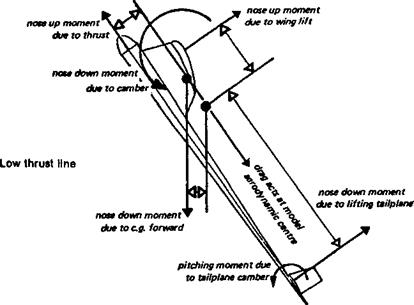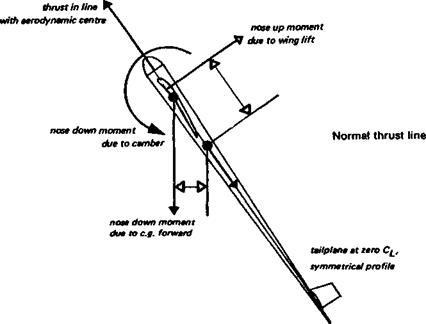SAILPLANES ON THE TOWLINE
Somewhat analogous to the stability and balance problems of powered models are the conditions prevailing when a glider is on tow. The force of the towline creates a pitching moment which must be balanced by the tailplane, and the speed of flight on tow, especially in the early stages, is greater than normal, so the model is more sensitive. A rudder tab setting just sufficient to cause a gentle turn on the glide may cause a violent yaw on tow, which explains why ‘auto-rudders’ are needed for free flight sailplanes. If a model has stability problems on the glide, it will almost certainly behave worse under tow. As usual, a good deal of experiment and trial is needed for consistent results. A further effect to be guarded against is the distortion of wings and slender fuselages during the tow, due to the combination of extra load from the line and additional speed. A model which is perfectly satisfactory on the glide may become uncontrollable on tow if the wings twist differentially or if a slight warp is present These effects too, are mainly matters for, practical solution by means of stiffer structures and more accurate constructional methods.
Sometimes when being launched by towline or winch, a sailplane will begin to swing from side to side more or less violently and may go so far over to one side that it turns
|
Fig. 12.20 Balance of forces on a climbing power model Moments about aerodynamic centre
|
|
|
through 180 degrees and either conies off the line or crashes heavily. The immediate solution in practice is to trim the elevator slightly down reducing the angle of attack of the mainplane. This is not possible with a free flight model, of course, but the basic cause is a wing operating at high lift coefficient. The position of the towhook too far forward may be a contributory factor.
As mentioned above, it is very difficult to achieve both spiral and weathercock lateral stability for all airspeeds and loading conditions. This tends to show up when a model is being pulled hard and fast by towline. Reducing the angle of attack changes the relationships of the wing, fin and dihedral-induced yaw and at the same time reduces the tension in the line.
Free flight sailplanes are usually towed fast and, after some time in the commonly practised ‘circular’ tow configuration while searching for lift, are pulled hard to increase airspeed then released with the line under tension, to gain some additional height This tends to send them into a stall, with loss of height, and if stability is not good, they may not recover at all. Much ingenuity has been put into designing towhooks for the circular tow. If some similar efforts were directed to elevator trim for adjusting to line tension, the problem might disappear.
Although wing tip stalling can happen on tow, it is very much less common than the side-to-side oscillation mentioned above which is not a tip-stall problem.













